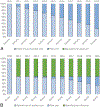Out-of-Pocket Spending Under the Affordable Care Act for Patients With Cancer
- PMID: 28537963
- PMCID: PMC10331630
- DOI: 10.1097/PPO.0000000000000262
Out-of-Pocket Spending Under the Affordable Care Act for Patients With Cancer
Abstract
The Patient Protection and Affordable Care Act (ACA) included several key provisions aimed at lowering the out-of-pocket cost burden for patients. In this review, we summarize the effect of 3 provisions under Medicaid, Medicare, and commercial insurance, respectively: expansion of Medicaid eligibility, closing the doughnut hole for Medicare Part D beneficiaries, and requiring an annual limit on out-of-pocket spending for commercially insured patients. Through this review, we find early evidence that these 3 ACA provisions have reduced the out-of-pocket burden or increased access to health insurance for many patients. Proposals to repeal and replace the ACA should consider retaining some of these important features that limit financial exposure for patients. At the same time, we have highlighted some important gaps left by the ACA that could be targeted by replacement plans. Addressing these issues may help to increase access to care and affordability for patients with cancer and without.
Figures




References
-
- American Cancer Society. Cancer Facts & Figures 2016. Atlanta, GA: ACS; 2016.
-
- Bennette CS, Richards C, Sullivan SD, et al. Steady increase in prices for oral anticancer drugs after market launch suggests a lack of competitive pressure. Health Aff (Millwood). 2016;35:805–812. - PubMed
-
- Dusetzina SB. Drug pricing trends for orally administered anticancer medications reimbursed by commercial health plans, 2000–2014. JAMA Oncol. 2016;2:960–961. - PubMed
-
- Howard DH, Bach PB, Berndt ER, et al. Pricing in the market for anticancer drugs. J Econ Perspect. 2015;29:139–162. - PubMed
MeSH terms
Grants and funding
LinkOut - more resources
Full Text Sources
Other Literature Sources

